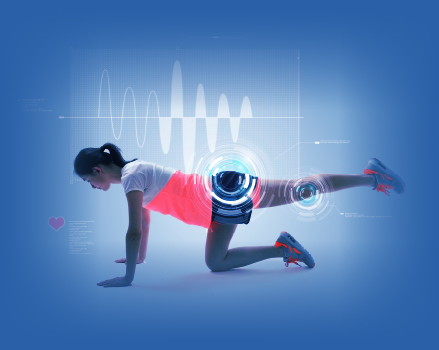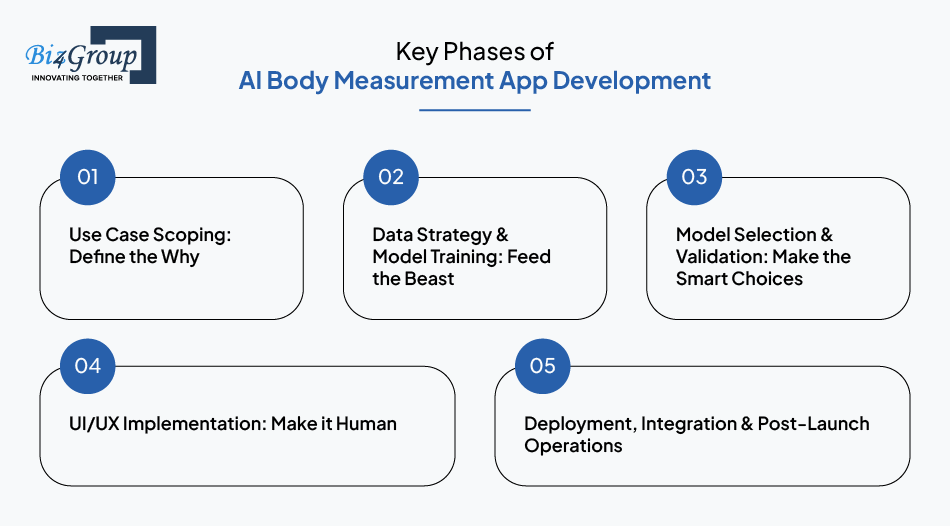Basic AI Chatbot Pricing: A simple chatbot that can answer questions about a product or service might cost around $10,000 to develop.
Read More

TL; DR

AI body measurement app development is revolutionizing industries like fashion, fitness, and health with accurate, selfie-based body analysis.

Key technologies include computer vision, machine learning, visual-language models (VLMs), and 3D reconstruction from 2D images.

GluteAI, developed by Biz4Group, showcases how AI can score glute muscle zones and offer personalized workout suggestions using VLMs.

Challenges include measurement accuracy, data privacy, model bias, and maintaining user trust—solved through careful design, prompt tuning, and secure architecture.

The global body composition monitoring market is projected to hit $1.31 billion by 2034, highlighting strong commercial demand for AI-powered solutions.

Smart deployment, user-centric design, and compliance readiness are key to building a scalable, trusted AI body measurement solution.
AI is no longer just hype. It's becoming a practical tool in solving everyday problems—and body measurement is one of the most promising use cases.
Today, businesses across fashion, fitness, e-commerce, and healthcare are turning to AI-powered image analysis to deliver personalized, scalable, and touchless body measurements. The value? Less guesswork, fewer returns, more tailored experiences.
With smartphones becoming more advanced and AI models like Computer Vision and Visual-Language Models (VLMs) evolving rapidly, it's now possible to measure the human body with surprising accuracy—using just a selfie.
What we’re covering:
This is not just another AI trend.
It’s a business tool, a personalization engine, and an operational advantage — all rolled into one.
Let’s unpack that.
There's a buzz in the air about AI. Not the "take over the world" kind, but the "make life easier" kind. And guess what? It's sizing up the body measurement scene.
The global AI market isn't just growing; it's on a sprint. Valued at over $600 billion in 2024, projections have it soaring to $2.74 trillion by 2032.
But let's zoom into the body measurement niche. The body composition monitor and scale market is flexing its muscles too, expected to expand from $644.7 million in 2024 to a solid $1.31 billion by 2034, marking a steady CAGR of 7.4%.
AI in body measurement isn't just a fleeting trend; it's a response to real-world needs. From enhancing online shopping experiences to supporting personal health journeys, the fusion of AI and body measurement is reshaping industries and daily routines alike.
Build AI body measurement app that analyzes images, understands glute shapes, and delivers actionable results—fast, private, and at scale.
Let’s Build It Together
Where the real tech magic happens
Not gonna lie — it’s kind of wild what AI can do with a single photo these days. You upload a mirror selfie, and within seconds, it spits out your body measurements, estimates your shape, and even recommends which part of your glutes needs more attention. All without you moving a muscle (well, except the one that taps "upload").
But how? What’s really happening under the hood?
Let’s break it down into four pillars:
Computer vision is the part of AI that lets machines "see" and make sense of visual input. Think of it as the foundation — the AI equivalent of someone eyeing you up and down with laser precision (except not creepy at all).
If the photo quality is good, computer vision can get really accurate.
But it doesn't understand what it's seeing. That’s where the next player comes in.
The moment you think of computer vision software development, know that we’ve got you covered already! Explore how Biz4Group offers this service in IT industry.
Now that the app "sees" you, it has to interpret what it sees. That’s where deep learning models come in — trained on thousands (sometimes millions) of annotated body images.
These models aren’t always perfect. But with the right data training, they can deliver body measurement predictions that are scary close to what a tailor with a tape measure might get.
This one’s the new kid on the block — and possibly the most exciting.
Visual-Language Models (like GPT-4 Vision, LLaMA 3.2, or Gemini 1.5) are designed to understand both images and text at the same time.
Imagine uploading your photo and asking:
“What’s my waist size?”
“Which part of my glute is underdeveloped?”
“What workouts should I focus on?”
And the AI doesn’t just process the image — it responds to your question in natural language. GluteAI does exactly this by feeding your image into a VLM and asking the model to reason through body zones, identify shapes, and recommend actions. (It's like having a fitness coach and a diagnostic engine rolled into one.)
These models can:
They’re the key to turning a raw AI model into a human-friendly product.
Finally, for apps that want to go all out — there’s 3D.
Using smart geometry and statistical modeling, AI can reconstruct a 3D avatar from just one or two 2D photos. No body scanner, no hardware — just you and your phone.
Why it matters:
Some platforms like Bodygram, 3DLOOK, and even open-source projects are experimenting with these pipelines to deliver near-lifelike reconstructions.
So, AI sees you (computer vision), understands you (ML/DL), talks to you (VLMs), and can even recreate you (3D reconstruction).
All from a picture.
Use computer vision and visual-language models to deliver precise, selfie-based body measurements—no tape, no guesswork, just accurate insights.
Schedule a Call
From “cool idea” to actual working product — here’s how the sausage gets made.
Let’s say you’ve decided to build an AI body measurement app. You’ve got the concept. Maybe even a few investor calls lined up. What now?
This section’s for the product folks, the AI leads, and the tech execs asking the real questions:
“What do we need?”
“How long will it take?”
“What could go wrong?”
Let’s walk through the five core stages that get this kind of app off the whiteboard and into users’ hands.
Before a single line of code is written, you’ve got to answer this:
What problem are we solving — and for whom?
Some common goals:
You also define:
Start with an MVP:
Don’t build the whole AI stack on day one. Instead, launch with core features—like image capture, pose detection, and one or two key measurements. Test the market. Validate the UX. Then scale to include VLMs, workout recommendations, or API integrations later.
Here’s an interesting guide for you when it comes to develop custom MVP software, powered by AI.
Your AI is only as good as the data you feed it. And this is where things start getting real.
You can either:
Some startups also blend synthetic data — 3D avatar renderings, AI-generated bodies — to scale fast without privacy headaches.
Time to bring in the nerds. (Affectionately, of course.)
You’re choosing between:
And then you validate:
Pro tip: Always test for edge cases — weird poses, dark rooms, half-body photos. Because your users will surprise you.
This is where you stop thinking to develop AI body measurement app and start thinking like a user.
Ask yourself:
Best-in-class UX patterns include:
Because let’s be honest — no one wants to see “waist = 743.22mm” in Comic Sans.
Speaking of UI/UX, you may want to explore cost for UI/UX design.
So, your AI model is trained, your UX is polished, and it's working beautifully on a test device. Now what?
This is where your app enters the real world.
But here’s the thing: launching is not the finish line. It's just the end of lap one.
Your model needs to evolve, just like your users do.
AI isn’t magic — it’s iteration. And nothing improves a system faster than live user feedback.
Apps like GluteAI use this loop to improve not only prediction quality but also workout recommendations.
You’re dealing with biometric data — which means you’re not just playing in the tech world, you’re also in legal territory.
Automate sizing with an AI that reads body dimensions from images and recommends the perfect fit across every customer profile.
Book a Free ConsultationSource: Glute AI
Because theory’s nice, but results are better.
So far, we’ve talked about the building blocks, the strategy, and the red flags.
Now let’s look at how Biz4Group, an AI development company in USA — took all of that and turned it into a functioning, enterprise AI solution: GluteAI.
It’s a body measurement app using AI. But more specifically?
It’s a gluteal muscle analyzer.
(Yes, it literally scores your butt. And yes, that’s both useful and impressive.)
Source: Pinterest
GluteAI takes the user through a super simple flow:
It’s part measurement tool, part AI coach.
And users love the feedback because it’s specific, visual, and actionable.
Biz4Group didn’t just slap an AI label on a fitness tracker. The team went deep.
This wasn’t just a “build and deploy” kind of deal. They hit real-world snags — and solved them.
Having mentioned about image understanding above, here’s how Biz4Group offers its services related to Generative AI for image analysis. Explore and figure out for your body measurement app project!
Why does GluteAI matter from a business POV?
GluteAI didn’t just talk about AI-powered body shape analysis — it did it.
And it shows you don’t need fancy sensors or high-end gyms.
Just smart design, solid engineering, and a selfie.
So, what have we learned (besides the fact that AI can literally analyze your butt)?
Here’s the thing — AI body measurement apps aren’t hype anymore. They’re real. They work. And when done right, they solve actual problems across industries that care about fit, function, form, and feedback.
Whether you're doing AI app development for glute analysis to reduce clothing returns, track fitness progress, or personalize health recommendations, the tech is there.
So is the business case.
But — and this is key — the win isn’t just in launching the app.
It’s in doing it responsibly.
It’s in thinking about bias, user trust, privacy, and experience.
It’s in choosing the right tools (hello VLMs), collecting the right data, and knowing where to draw the line for the sake of AI body measurement app development.
GluteAI proved it can be done — blending computer vision, visual-language models, APIs, and UX into one tight, purposeful flow. And that’s just one use case.
So, if you're an AI strategist, product leader, or exec on the fence about investing in this space?
Here’s your sign:
This is worth building.
Just make sure you build it right.
From gym apps to health diagnostics, unlock AI-driven analysis that scores, segments, and suggests like a personal trainer.
Let’s ConnectAI body measurement app development involves defining the target use case. Acquiring and preprocessing diverse datasets. Selecting and training suitable machine learning models, integrating user-friendly UI/UX designs, and ensuring compliance with data privacy regulations. Continuous monitoring and updates are essential for maintaining accuracy and user trust
AI body measurement apps prioritize user privacy by implementing data encryption, allowing users to opt out of photo storage, and processing images directly on devices when possible. They also avoid storing personally identifiable information (PII) with image metadata, ensuring users' personal data remains secure.
Challenges for AI app development for body measurement include variations in lighting, user clothing, and camera angles, which can affect measurement precision. To mitigate these, apps employ pose guides, real-time capture validation, and calibrate models to account for different devices and body types, enhancing overall accuracy.
Developers can reduce bias by diversifying training datasets to include various ages, genders, ethnicities, and body types. Regular audits for demographic performance gaps and implementing quality assurance loops with diverse test sets further help in minimizing biases.
These apps are utilized in online shopping for accurate size recommendations, tailoring services for digital measurements, fitness apps to track body metrics over time, and healthcare for creating custom-fitted medical garments, enhancing user experience across industries.
IN YOUR BUSINESS FOR FREE
Our website require some cookies to function properly. Read our privacy policy to know more.